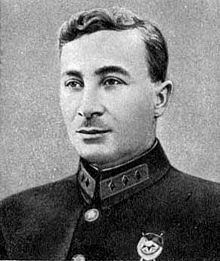Years of service 1914 — 1931 Rank General officer | Name Vladimir Triandafillov | |
 | ||
Battles/wars World War IRussian Civil War Books The Nature of the Operations of Modern Armies Similar People Boris Shaposhnikov, Mikhail Tukhachevsky, Kliment Voroshilov, Aleksandr Vasilevsky, Semyon Timoshenko | ||
Vladimir Kiriakovitch Triandafillov (Russian: Влади́мир Кириа́кович Триандафи́ллов; 14 March 1894 – 12 July 1931) was a Soviet military commander and theoretician.
Contents
Biography
He was born on March 14, 1894, in Magaradzhik village in Kars Oblast, then in the Russian Empire (today in Mağaracık, Turkey) of Pontic Greek parents. The family name derives from triantáfyllo, τριαντάφυλλο, Modern Greek for the rose flower. His family had moved to Russia. Graduating from the Moscow Praporshchik School in 1915, he served in the Russian Army in World War I, earning the rank of captain. During the Russian Civil War, he rose in rank up to brigade commander while fighting on various fronts. In 1923, he was appointed chief of the Operations Directions of the Soviet General Staff and Deputy Chief of the General Staff.
Vladimir Triandafillov was the author of two fundamental military doctrine works: Scale of the operations of modern armies, published in 1926 and Characteristics of the operations of the modern armies, published in 1929. In these two works, he elaborated his deep operations theory about the future warfare. The objective of a "deep operation" was to attack the enemy simultaneously throughout the depth of his ground force to induce a catastrophic failure in his defensive system. Highly mobile formations would then exploit this failure by breaking into the deep rear of the enemy and destroying his ability to rebuild his defenses.
Vladimir Triandafillov was killed in an aircraft crash on July 12, 1931 and was buried in the Kremlin Wall Necropolis. The quality of his work was realised late during World War II, when Georgy Zhukov said that his success was due to closely following Triandafillov's deep operations doctrine.
